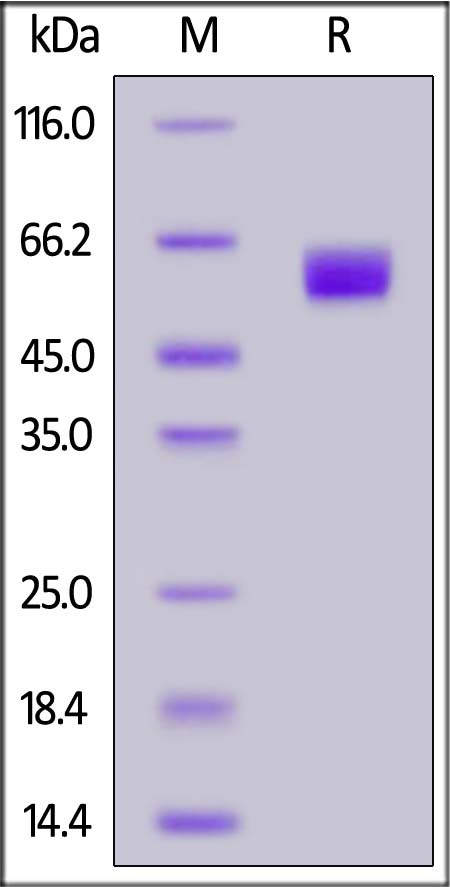分子别名(Synonym)
SLC3A2,CD98,4F2,4F2HC,4T2HC,CD98HC,MDU1,NACAE
表达区间及表达系统(Source)
FITC-Labeled Human CD98, His Tag (CD8-HF248) is expressed from human 293 cells (HEK293). It contains AA Arg 206 - Ala 630 (Accession # P08195-1).
Predicted N-terminus: His
Request for sequence
蛋白结构(Molecular Characterization)

This protein carries a polyhistidine tag at the N-terminus.
The protein has a calculated MW of 47.7 kDa. The protein migrates as 55-66 kDa under reducing (R) condition (SDS-PAGE) due to glycosylation.
Conjugate
FITC
Excitation source: 488 nm spectral line, argon-ion laser
Excitation Wavelength: 488 nm
Emission Wavelength: 535 nm
标记(Labeling)
The primary amines in the side chains of lysine residues and the N-terminus of the protein are conjugated with FITC using standard chemical labeling method. The residual FITC is removed by molecular sieve treatment during purification process.
蛋白标记度(FITC:Protein Ratio)
The FITC to protein molar ratio is 1-3.
内毒素(Endotoxin)
Less than 1.0 EU per μg by the LAL method.
纯度(Purity)
>95% as determined by SDS-PAGE.
制剂(Formulation)
Lyophilized from 0.22 μm filtered solution in PBS, pH7.4. Normally trehalose is added as protectant before lyophilization.
Contact us for customized product form or formulation.
重构方法(Reconstitution)
Please see Certificate of Analysis for specific instructions.
For best performance, we strongly recommend you to follow the reconstitution protocol provided in the CoA.
存储(Storage)
For long term storage, the product should be stored at lyophilized state at -20°C or lower.
Please protect from light and avoid repeated freeze-thaw cycles.
This product is stable after storage at:
- -20°C to -70°C for 12 months in lyophilized state;
- -70°C for 3 months under sterile conditions after reconstitution.
质量管理控制体系(QMS)
电泳(SDS-PAGE)

FITC-Labeled Human CD98, His Tag on SDS-PAGE under reducing (R) condition. The gel was stained with Coomassie Blue. The purity of the protein is greater than 95%.
背景(Background)
CD antigen CD98 is also known as 4F2 cell-surface antigen heavy chain (4F2hc), 4F2 heavy chain antigen, Solute carrier family 3 member 2 (SLC3A2), Lymphocyte activation antigen 4F2 large subunit, is a single-pass type I I membrane protein which belongs to the SLC3A transporter family.. SLC3A2 / CD98 is expressed ubiquitously in all tissues tested with highest levels detected in kidney, placenta and testis and weakest level in thymus. SLC3A2 / CD98 is required for the function of light chain amino-acid transporters and also involved in sodium-independent, high-affinity transport of large neutral amino acids such as phenylalanine, tyrosine, leucine, arginine and tryptophan. CD98 involved in guiding and targeting of LAT1 and LAT2 to the plasma membrane. When associated with SLC7A5 or SLC7A8, CD98 involved in the cellular activity of small molecular weight nitrosothiols, via the stereoselective transport of L-nitrosocysteine (L-CNSO) across the transmembrane. Together with ICAM1, regulates the transport activity LAT2 in polarized intestinal cells, by generating and delivering intracellular signals.























































 膜杰作
膜杰作 Star Staining
Star Staining
















